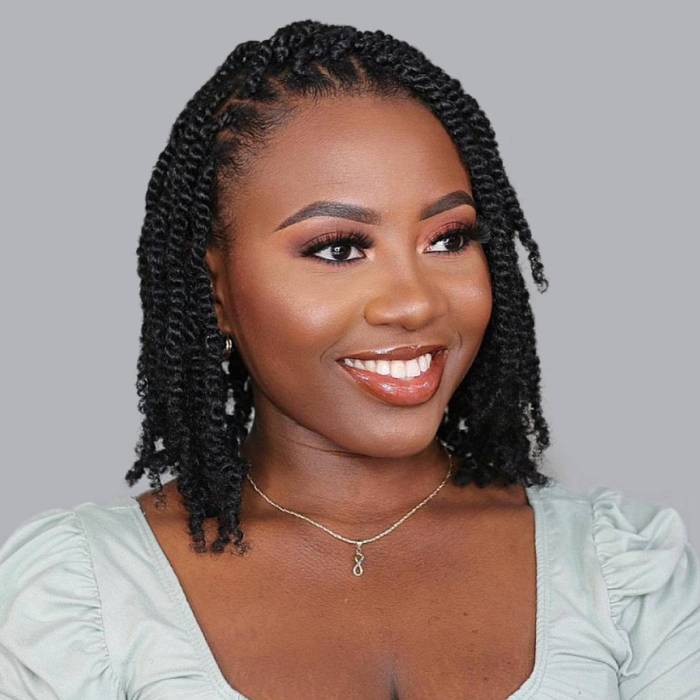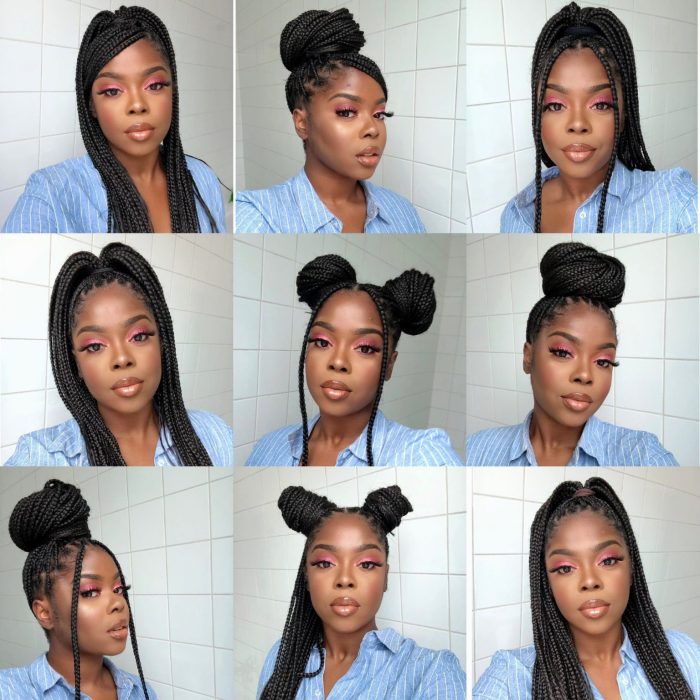Braid Hairstyles on Natural Hair
Braid Hairstyles on Natural Hair
Braid hairstyles on natural hair – Braiding natural hair offers a versatile and protective styling option, encompassing a rich history and diverse techniques. This exploration delves into the various braid styles, preparation methods, maintenance tips, and styling inspiration to empower you in achieving beautiful and healthy braided looks.
Introduction to Braid Hairstyles on Natural Hair

Source: latest-hairstyles.com
Braid hairstyles demonstrate remarkable adaptability across diverse hair textures, from fine and straight to thick and coily. Their protective nature shields natural hair from environmental damage and manipulation, promoting length retention and minimizing breakage. Historically, braiding has held significant cultural importance across numerous societies, serving as a form of self-expression, adornment, and social signaling. African cultures, for example, boast a rich tapestry of braiding traditions, with styles often carrying deep symbolic meanings.
Types of Braid Hairstyles
Numerous braid styles cater to various hair lengths, textures, and skill levels. The following table provides an overview of popular options:
| Braid Name | Description | Hair Length Suitability | Skill Level |
|---|---|---|---|
| Cornrows | Close-to-the-scalp braids, often in straight lines. | Medium to long | Intermediate to Advanced |
| Box Braids | Square-sectioned braids, typically using extensions. | Short to long | Intermediate to Advanced |
| Individual Braids | Single braids created throughout the head. | Medium to long | Beginner to Intermediate |
| Feed-in Braids | Braids that gradually incorporate more hair along the length. | Medium to long | Intermediate |
| Tree Braids | Braids that branch out from a central point, resembling a tree. | Medium to long | Advanced |
Cornrows involve tightly braiding hair close to the scalp, creating intricate patterns. Box braids utilize hair extensions for length and volume, offering diverse styling possibilities. Individual braids are simpler, ideal for beginners, and provide a versatile base for various looks.
Hair Preparation and Product Recommendations
Proper hair preparation is crucial for successful and long-lasting braids. This involves thorough cleansing, deep conditioning, and detangling to prevent breakage and promote scalp health.
- Cleanse hair with a sulfate-free shampoo.
- Deep condition with a moisturizing treatment.
- Detangle hair gently using a wide-tooth comb or your fingers.
- Apply a leave-in conditioner for added moisture and protection.
Recommended products include leave-in conditioners (e.g., SheaMoisture Manuka Honey & Mafura Oil Intensive Hydration Leave-In Conditioner), hair oils (e.g., coconut oil, jojoba oil), and styling gels (e.g., Eco Styler Gel).
Braid Maintenance and Care
Maintaining the integrity and neatness of braids requires consistent care and attention. This includes regular scalp cleansing, moisturizing, and proper sleeping habits.
- Keep the scalp clean and moisturized to prevent dryness and irritation.
- Use a satin bonnet or scarf at night to minimize friction.
- Avoid excessive manipulation of the braids.
- Remove braids gently to avoid pulling or breaking hair. Use a leave-in conditioner to help the process.
Braid Styles for Different Occasions

Source: afronews.de
Braid styles readily adapt to diverse settings and personal preferences. Accessorizing adds personality and flair.
- Formal Events: Elegant updos with intricate braids, adorned with beads or decorative pins.
- Casual Outings: Loose, flowing braids or simple cornrows.
- Athletic Activities: Tight, secure braids that stay in place during movement.
Accessories like beads, ribbons, and hair cuffs add visual interest and personalization to braid styles.
Braiding Techniques and Tutorials, Braid hairstyles on natural hair
Mastering specific braiding techniques enhances styling versatility. This section focuses on creating a simple cornrow.
Begin by sectioning a small portion of hair near the hairline. Divide this section into three strands. Cross the right strand over the middle strand, then the left strand over the new middle strand. Continue this pattern, gradually incorporating more hair from the scalp into the braid as you go along. Maintain consistent tension throughout the braiding process to create a neat, even cornrow.
Avoid pulling too tightly, which can cause scalp discomfort or hair breakage. Ensure all strands are evenly distributed to avoid a lopsided braid. Practice makes perfect!
Inspiration and Styling Ideas
Numerous resources offer inspiration for braid styles. Experimenting with textures and colors expands creative possibilities.
- Websites and Blogs: NaturallyCurly, Black Girl Long Hair, Pinterest
- Social Media: Instagram, YouTube (search for hashtags like #naturalhairbraids, #braidstyles)
A mood board could feature sleek cornrows for short hair, voluminous box braids for medium-length hair, and intricate goddess braids for long hair, showcasing a range of textures from straight to tightly coiled, incorporating colors like auburn highlights in black hair, or vibrant jewel tones in lighter hair.
Essential Questionnaire: Braid Hairstyles On Natural Hair
How long do braids typically last on natural hair?
The lifespan of braids varies depending on the style, hair type, and maintenance. Generally, braids can last anywhere from 4 to 8 weeks.
Can I sleep with braids without damaging my hair?
Braid hairstyles offer a versatile and protective style for natural hair, allowing for creativity and minimizing manipulation. For those with shoulder-length hair considering a more formal look, exploring options like wedding updo hairstyles for shoulder-length hair can provide inspiration. Ultimately, the choice depends on personal preference, but incorporating braids into a wedding updo can be a stunning and practical solution, blending the best of both worlds.
Yes, but it’s recommended to protect your braids at night using a satin scarf or bonnet to minimize friction and breakage.
How often should I wash my hair while it’s braided?
Washing frequency depends on your scalp’s oiliness, but generally, washing every 2-3 weeks is sufficient to prevent buildup and maintain scalp health. Use a gentle cleanser.
What are the signs of scalp irritation under braids?
Signs include itching, redness, pain, or bumps. If experienced, consult a dermatologist or trichologist.












